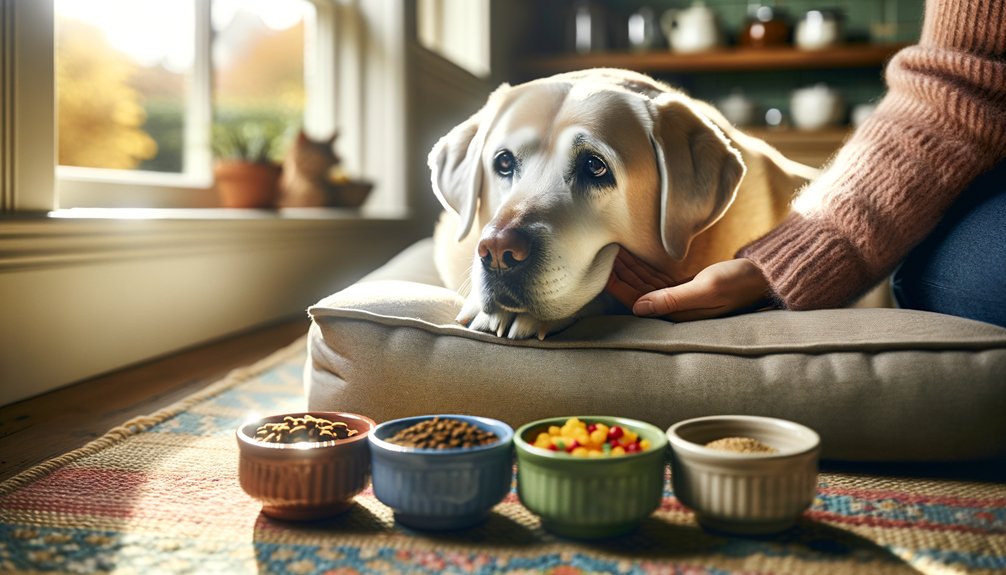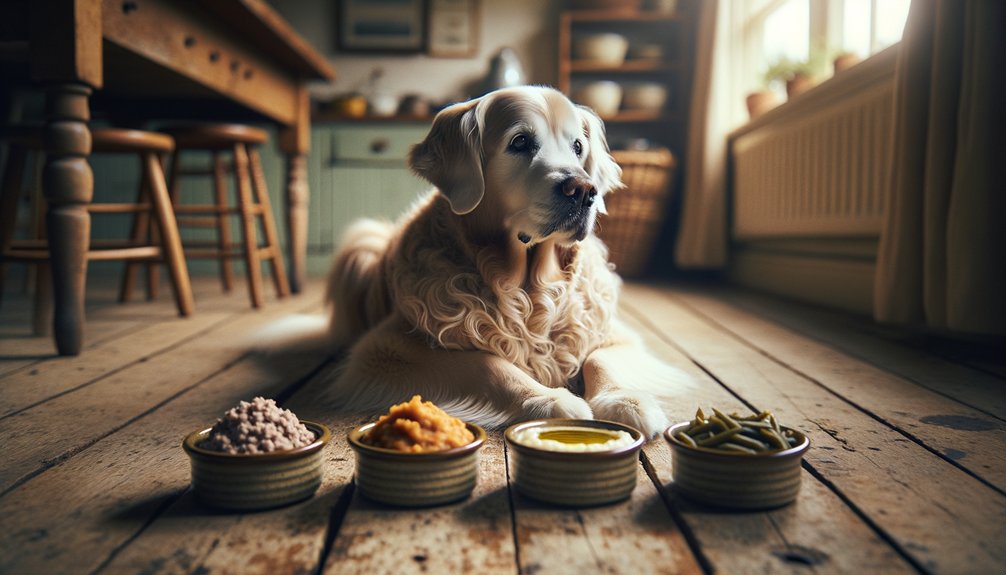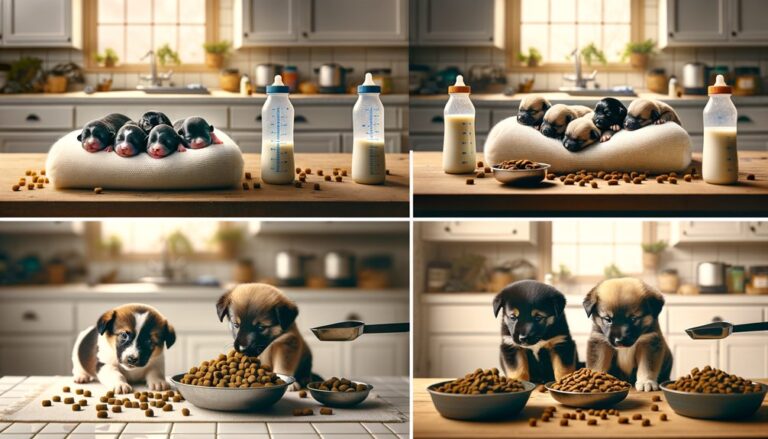The Best Fluffy Pancakes recipe you will fall in love with. Full of tips and tricks to help you make the best pancakes.

Maintaining muscle and organ health in senior dogs requires tailored macronutrient ratios — discover seven optimized plans to match age, weight, and conditions. About 50% of dogs show age-related weight or muscle changes macronutrient plans that preserve lean mass, control calories, and support organs—tailored to kidney, pancreas, weight, activity, and joint needs. Below are seven balanced ratio options with when and why you’d use each, plus practical tips to choose the best fit for your senior dog.
Key Takeaways
- Tailor macronutrient ratios to specific senior issues (weight loss, kidney disease, pancreatitis, hypothyroid, low activity).
- For muscle preservation use high-protein (≥25–30% DM), moderate-fat, low-carb with added fiber.
- For chronic kidney disease choose low-protein but highly digestible protein, moderate-fat rich in omega-3s, moderate carbs.
- For pancreatitis-prone seniors select low-fat, moderate-protein, moderate-carb, fed as small frequent meals.
- For low-activity or hypothyroid dogs consider moderate-protein, higher-fat, low-carb formulas with careful saturated fat limits.
High-Protein, Moderate-Fat, Low-Carb for Muscle Preservation

For many senior dogs aiming to preserve lean mass, you’ll often see recommendations around a higher protein intake—typically above 25–30% on a dry matter basis—paired with moderate fat to meet energy needs and low carbohydrates to limit excess calories.
That ratio isn’t one-size-fits-all, though: your dog’s activity level, body condition, and any health issues (like kidney disease) will change the ideal balance.
Talk with your veterinarian to tailor the exact protein, fat, and carb targets for your pet.
What is the ideal macronutrient ratio for dogs?
Why aim for a high-protein, moderate-fat, low-carb profile in senior dogs? You’ll preserve lean mass, support mobility, and reduce insulin-driven fat gain. Aim for protein above 25–30% on a dry matter basis from high-quality sources, adjusting for your dog’s own age needs and any kidney concerns—consult your vet. Keep fats moderate and focused on omega-3 and omega-6 for joints, coat, and extra calories if weight’s an issue. Limit digestible carbs to control body composition, while including fiber for gut regularity. Monitor hydration status closely, since moisture affects intake and renal load. Balance is key: tailor ratios to activity, health conditions, and palatability so your senior stays strong and free.
Low-Protein, Moderate-Fat, Moderate-Carb for Chronic Kidney Disease

Wondering how to adjust macronutrients when your senior dog has chronic kidney disease? You’ll often aim for a low-protein, moderate-fat, moderate-carb plan that’s kidney friendly while still protecting muscle mass. Lowering protein reduces nitrogenous waste and phosphorus load; choose high-quality, highly digestible protein sources and monitor intake to avoid muscle loss. Moderate fats provide concentrated calories to maintain weight and support skin and joints; include omega-3s for anti-inflammatory benefits. Moderate carbohydrates supply readily available energy and digestive fiber. Focus on palatable formulations and appetite stimulation techniques—warming food, adding broth, or using flavor enhancers—to preserve intake. Work closely with your veterinarian to tailor phosphorus, sodium, and calorie targets and reassess regularly as the disease progresses.
Low-Fat, Moderate-Protein, Moderate-Carb for Pancreatitis-Prone Seniors
How should you adjust calories and nutrients when a senior dog is prone to pancreatitis? You’ll prioritize a low fat, moderate protein, moderate carb approach to reduce pancreatic stimulation while preserving muscle. Choose lean, easily digestible protein sources and split daily calories into multiple small meals to lower postprandial fat spikes. Carbohydrates should be complex and fiber-rich to slow gastric emptying and support glycemic stability. Keep overall calories appropriate for weight—avoid high-calorie fats but don’t underfeed; muscle loss worsens outcomes. Monitor appetite, stool quality, and triglycerides regularly with your vet, and adjust formulations based on bloodwork and clinical response. Treat flare-ups promptly and re-evaluate long-term macronutrient balance with professional guidance.
Calorie-Restricted: Moderate-Protein, Low-Fat, Moderate-Carb for Weight Loss
When your senior dog needs to lose weight, a calorie-restricted diet with moderate protein, low fat, and moderate carbohydrates helps preserve lean mass while reducing body fat. You’ll aim for high-quality protein to support muscle and limit calorie-dense fat to create a safe deficit; studies show preserving protein intake reduces sarcopenia risks associated with irreversible aging. Moderate carbs provide usable energy and fiber for satiety and stool regularity. Monitor portion control, weigh your dog regularly, and adjust calories slowly to avoid muscle loss. Keep dental health in mind: softer, palatable options that clean teeth or tailored dental care can improve intake without extra calories. Always work with your veterinarian to tailor the plan and monitor metabolic or orthopedic issues.
Moderate-Protein, High-Fat, Low-Carb for Low-Activity or Hypothyroid Dogs
Why might a moderate-protein, high-fat, low-carb plan suit low-activity or hypothyroid senior dogs? You’ll find this balance can provide concentrated calories without excess carbs that might promote weight gain when activity and metabolism drop. It meets protein needs to preserve lean mass while prioritizing fat for energy and palatability, supporting a weak senior appetite.
| Benefit | Why it helps | What to watch |
|---|---|---|
| Energy density | Fat supplies calories with less volume | Monitor weight gain |
| Muscle maintenance | Moderate protein sustains lean mass | Adjust for kidney disease |
| Palatability | Fats boost aroma and intake | Avoid excessive saturated fat |
Consult your veterinarian to tailor ratios to your dog’s labs, activity, and health goals.
The Omega-Rich Diet That Keeps Senior Dogs Moving Comfortably
Why Nutrition Matters for Senior Dogs with Joint Issues
As dogs age, stiffness, arthritis, and reduced mobility often appear. Many owners ask: Can diet really help? The answer is yes. A carefully balanced, omega-rich diet protects joints, reduces inflammation, and helps senior dogs stay active and pain-free.
Core Nutrition Strategy for Joint Health
1. Moderate Protein for Muscle Preservation
- Maintains lean muscle without stressing kidneys
- Best sources: chicken, fish, eggs
- Why it matters: Too much protein can burden aging kidneys, while too little weakens muscles.
2. Omega-3s (EPA/DHA) for Inflammation Control
- Found in fish oil or algal oil
- Reduce inflammation, protect cartilage, ease arthritis pain
- Research shows measurable improvements in mobility and comfort (see study: https://www.mdpi.com/2076-2615/14/21/3108).
3. Moderate Fat for Energy and Joint Lubrication
- Provides steady energy
- Supports joint lubrication and vitality
- Balanced fat intake prevents excess weight gain.
4. Carbohydrates for Weight Management
- Deliver digestible calories and fiber
- Help prevent obesity, a major risk factor for joint stress
- Chosen wisely, carbs aid digestion and satiety.
Key Benefits of an Omega-Rich Diet
- Joint Support → Improved mobility, less pain
- Muscle Preservation → Stronger, leaner body
- Weight Control → Reduced stress on joints
- Vitality → Steady energy for daily activity
What Research Shows
Skeptical owners sometimes wonder, is this just theory? Studies on EPA and DHA supplementation in senior dogs demonstrate:
- Reduced joint inflammation
- Improved walking ability and comfort
- Lower reliance on pain medication
Nutrition, in this sense, becomes a form of gentle medicine (see study: https://www.mdpi.com/2076-2615/14/21/3108).
Practical Guidance for Owners
- Add fish oil or algal oil for omega-3s
- Choose high-quality protein sources
- Monitor weight, mobility, and bloodwork
- Consult your veterinarian for adjustments
Bottom Line
An Omega-Rich, Moderate-Protein diet is more than food — it is a joint-care strategy. With the right balance of protein, fat, carbs, and omega-3s, senior dogs can enjoy freedom of movement, less pain, and healthier aging.
Senior Working Dogs Nutrition: High-Protein, High-Fat, Low-Carb for Energy & Recovery
As dogs get older, their bodies change — but senior working dogs still need strength, stamina, and quick recovery to keep doing what they love. Whether it’s herding sheep, supporting rescue teams, or assisting as service dogs, the right diet helps them stay active, sharp, and full of life.
Protein: Building Blocks for Strength & Longevity
- Focus on high-quality animal protein (≥25–30% dry matter).
- Protein helps maintain muscle mass, supports recovery after activity, and strengthens the immune system.
- Enough protein also helps fight sarcopenia (age-related muscle loss) and reduces inflammation that can slow older dogs down.
Fats: Energy Density & Brain Support
- Add digestible fats to provide long-lasting energy.
- Medium-chain triglycerides (MCTs) give quick fuel and support brain health.
- Research shows MCTs can improve brain metabolism and may help delay cognitive decline in senior dogs.
Carbohydrates: Controlled but Functional
- Keep carbs low but not zero.
- Choose fiber-rich sources to support digestion, regulate stool quality, and avoid blood sugar spikes.
- Balanced carbs also help maintain a healthy gut microbiome.
Joint & Mobility Support
- Many older working dogs deal with joint stiffness or osteoarthritis.
- Nutrients like glucosamine, chondroitin, and green-lipped mussel extract can support joint health and mobility.
Monitoring & Personalization
- Keep an eye on weight, kidney function, heart health, and digestion.
- Adjust the diet with the help of a veterinarian, following trusted guidelines.
- A personalized plan helps prevent kidney stress, obesity, and joint strain.
Practical Feeding Tips
- Offer tasty, easy-to-eat meals — warming food or adding toppers can encourage picky eaters.
- Make sure they stay hydrated, using wet food or broth toppers to support kidney and overall health.
Final Takeaway
With the right mix of protein, fats, controlled carbs, and targeted supplements, guided by veterinary expertise, senior working dogs can keep their energy, independence, and joy well into their later years. Nutrition isn’t just fuel — it’s the key to helping them stay strong, alert, and happy.
Sources
- American Animal Hospital Association (AAHA) – Senior Care Guidelines for Dogs and Cats (2023)
- World Small Animal Veterinary Association (WSAVA) – Global Nutrition Guidelines
- FEDIAF – Nutritional Guidelines for Complete and Complementary Pet Food for Cats and Dogs (2025)
- Advances in Small Animal Care – Nutrition for Senior Pets (2024)
- VCA Animal Hospitals – Nutrition for Working and Service Dogs
- Springer – Nutrition and Aging in Dogs and Cats (2024)
Disclaimer
This article is for informational purposes only. It is not a substitute for professional veterinary advice, diagnosis, or treatment. Always consult your veterinarian before making changes to your dog’s diet, supplements, or care routine. Each dog is unique, and their needs may vary depending on breed, age, health, and activity level.
Frequently Asked Questions
How Do Macronutrient Needs Change for Mixed-Breed Versus Purebred Seniors?
Like a fingerprint, your mixed-breed or purebred senior’s needs differ: you’ll adjust macronutrient distribution based on individual size, health and aging metabolism changes, so you’ll consult evidence-based vet guidance for precise, freedom-respecting choices.
Can Supplements Replace Dietary Macronutrient Adjustments?
No — you shouldn’t rely on supplements to replace macronutrient changes; supplemental vitamins and synthetic fats can fill gaps, but whole-food protein, natural fats, and fiber remain essential, so consult your vet for tailored adjustments.
How Do I Transition My Senior Dog Between These Diet Types?
Sure — you won’t confuse your dog ratios, monitoring appetite, weight, stools, and consulting your vet for evidence-based adjustments.
Are Homemade Diets Safe for Senior Dogs With Special Macronutrient Needs?
Yes — you can use homemade diets safely for seniors, but you’ll need veterinary oversight and nutritional testing; prioritize homemade safety, nutrient density, balanced macros, and supplements to meet age‑related needs and avoid deficiencies.
How Do Medications Interact With Different Macronutrient Ratios?
About 40% of dogs on chronic meds show altered absorption; you’ll see medication diet interactions affect drug uptake and efficacy, so you should consider nutrient tolerance testing and adjust macronutrients under vet guidance for safe, flexible feeding.
Conclusion
When selecting the best diet for senior dogs (also called aging dogs, older pets, or geriatric dogs), remember that no single macronutrient ratio works for every case. The most effective approach is a personalized, veterinarian-approved nutrition plan that adapts to your dog’s health condition, activity level, age, and lifestyle. This ensures your pet receives the right balance of nutrients for longevity, mobility, vitality, and overall well-being.
Read more: https://www.petmd.com/dog/nutrition
Protein for Senior Dogs
Choose high-quality, digestible protein sources such as chicken, turkey, fish, or eggs. Adequate protein helps:
- Preserve muscle mass
- Support immune function
- Promote healthy aging
- Maintain energy levels in older dogs
Read more: https://www.akc.org/expert-advice/nutrition/feeding-senior-dogs/
Fats and Omega-3 Fatty Acids
Incorporate healthy fats, especially omega-3 fatty acids from fish oil, salmon, or flaxseed. These nutrients:
- Reduce inflammation
- Protect joints and skin
- Enhance heart and brain health
- Support cognitive performance in senior pets
Read more: https://vcahospitals.com/know-your-pet/fish-oil-supplements-for-dogs-and-cats
Carbohydrates for Energy & Digestion
Use tailored, easily digestible carbohydrates like sweet potatoes, oats, or brown rice. They:
- Aid weight management
- Improve digestive balance
- Provide sustained energy
- Help regulate blood sugar in older dogs
Veterinary Guidance
Work closely with your veterinarian to monitor:
- Bloodwork and lab results
- Weight and body condition
- Mobility and joint health
- Cognitive changes
Adjust nutrient ratios as your dog’s needs evolve with age.
💡 Read more: https://www.aaha.org/aaha-guidelines/senior-care-configuration/senior-care/
Key takeaway: A balanced senior dog diet—rich in protein, optimized in fats, and adapted in carbs—offers the best path to longevity, vitality, mobility, and healthy aging.
FAQ Add-on: Senior Dog Nutrition Questions
Q1: What is the best protein source for senior dogs? A: Lean meats like chicken, turkey, and fish provide digestible protein that helps maintain muscle mass and supports healthy aging.
➡️ Read more: https://www.akc.org/expert-advice/nutrition/best-food-for-senior-dogs/
Q2: Why are omega-3 fatty acids important for older dogs? A: Omega-3s reduce inflammation, support joint health, improve skin and coat, and may enhance cognitive performance.
➡️ Read more: https://vcahospitals.com/know-your-pet/fish-oil-supplements-for-dogs-and-cats
Q3: How can I manage my senior dog’s weight through diet? A: Use controlled portions of digestible carbs, monitor calorie intake, and adjust fat levels under veterinary guidance.
➡️ Read more: https://www.petmd.com/dog/nutrition/evr_dg_weight_management_in_dogs
Q4: Should I consult a veterinarian before changing my dog’s diet? A: Yes. A veterinarian can track bloodwork, mobility, and overall health to ensure the diet supports longevity and well-being.
➡️ Read more: https://www.aaha.org/aaha-guidelines/senior-care-configuration/senior-care/









